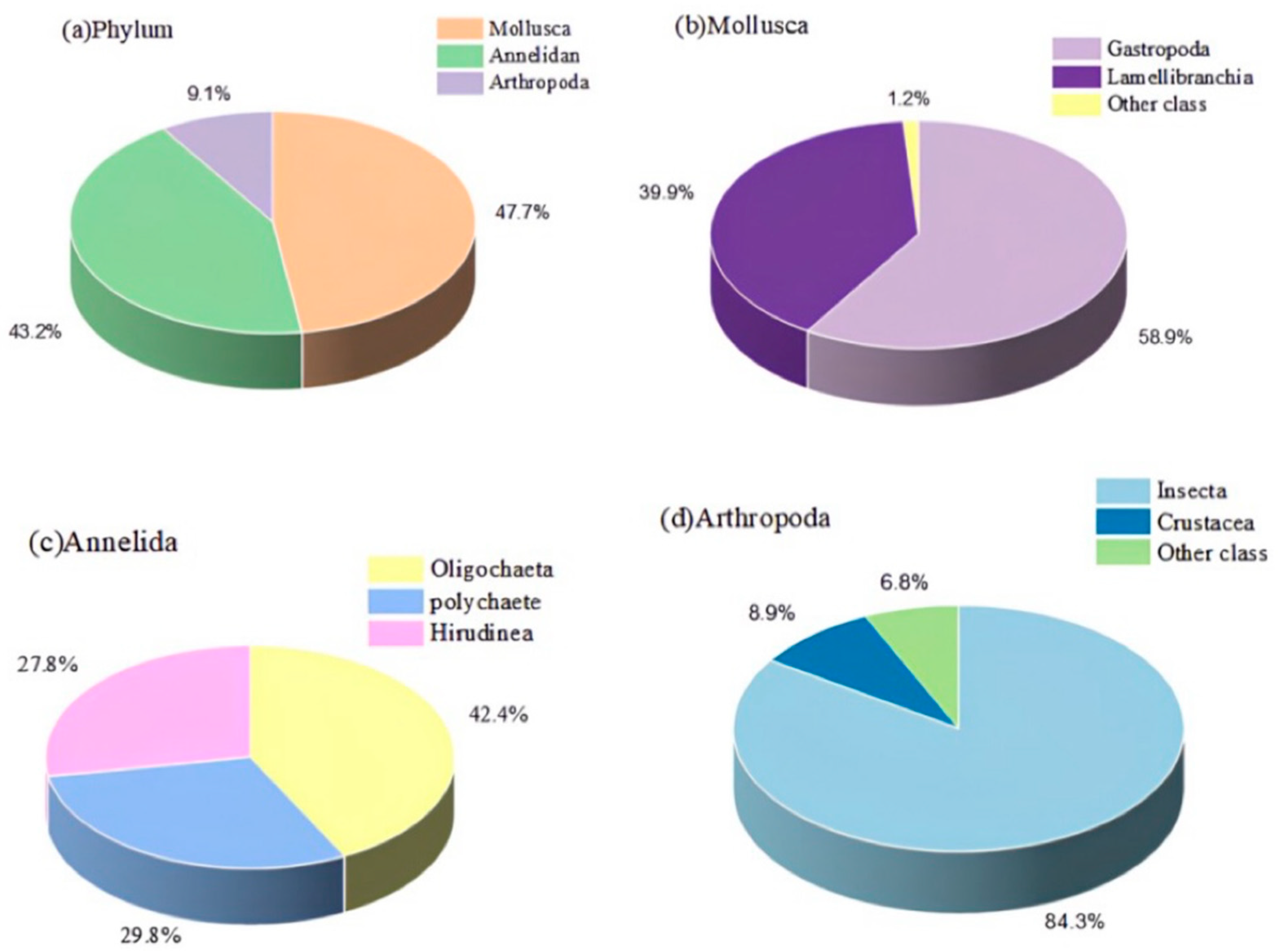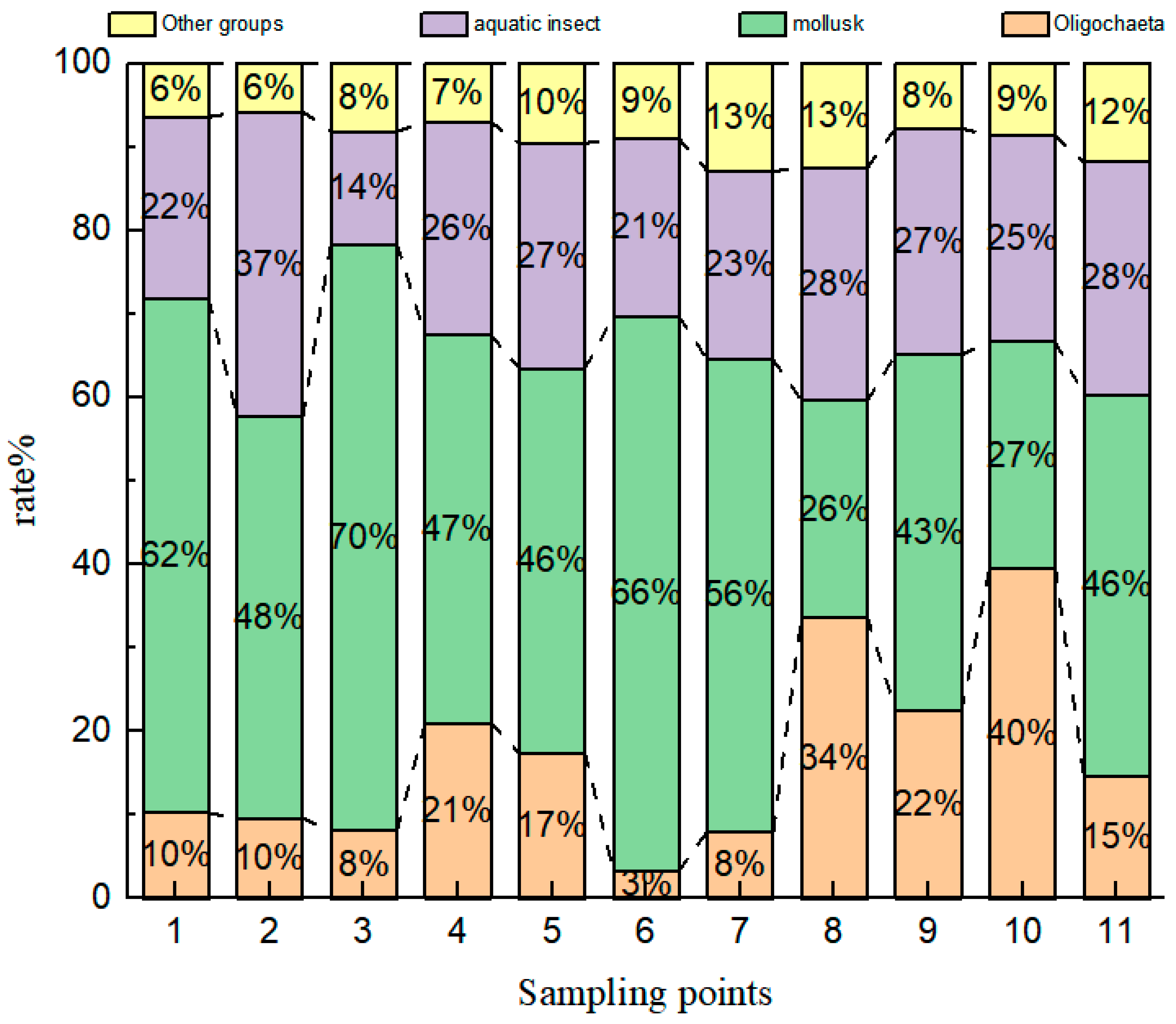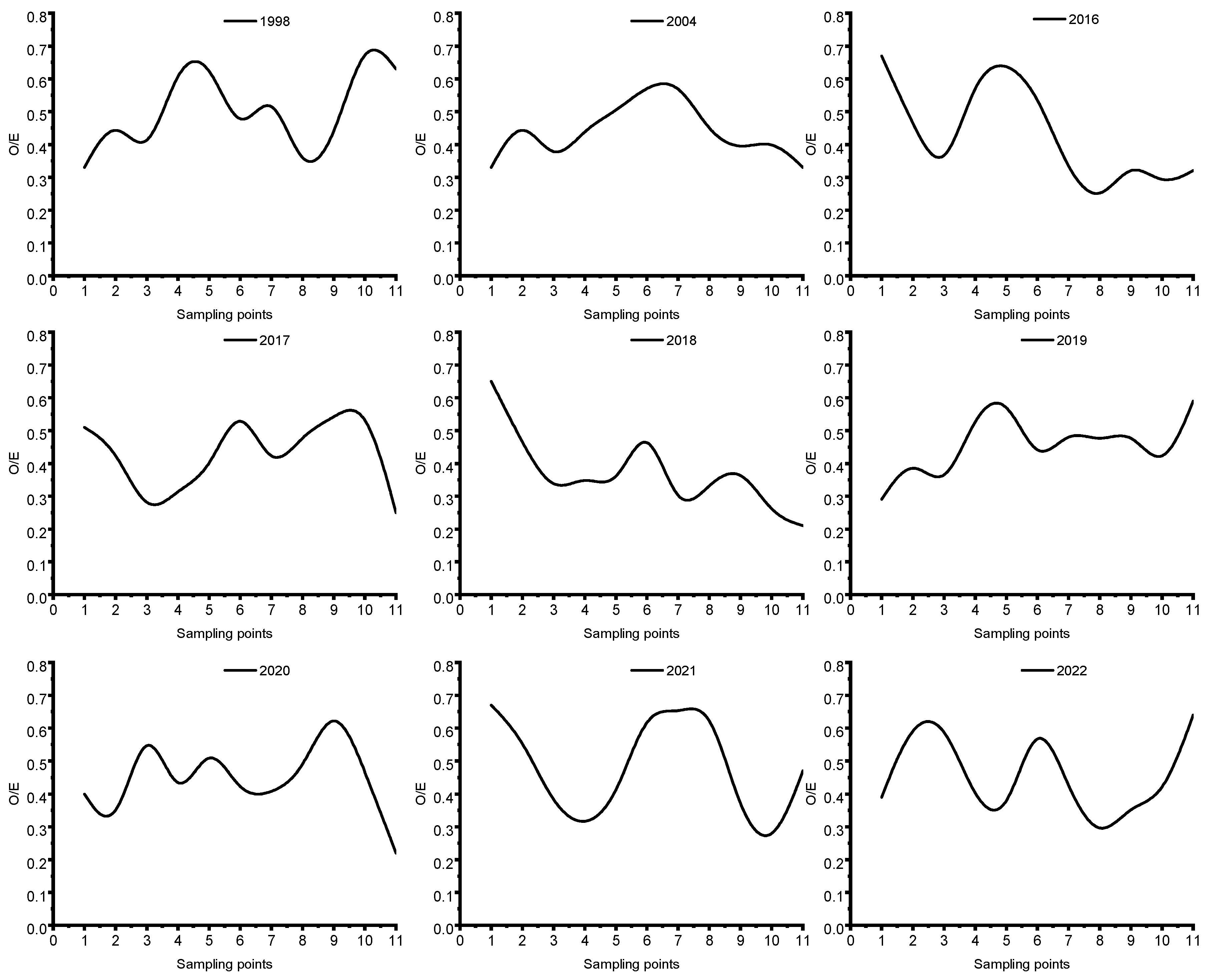Assessment of Organic Matter Influence on the Ecological Integrity of Poyang Lake Using O/E Model and Chemical–Biological Indices over the Past Two Decades
Abstract
:1. Introduction
2. Materials and Methods
2.1. Study Region
2.2. Data Acquisition
2.2.1. History Data
2.2.2. Field Sample Collection and Processing
2.3. Construction of Assessment Method
2.3.1. Construction of the O/E Index Model
2.3.2. Calculation of the Biochemical Composite Index
3. Results and Discussion
3.1. The Composition and Structural Changes of Benthic Community in Poyang Lake over the Past 20 Years
3.2. Evaluation of Water Ecological Health Based on the O/E Index
3.3. Combined Chemistry-Biology Index Health Assessment
4. Conclusions
Author Contributions
Funding
Institutional Review Board Statement
Informed Consent Statement
Data Availability Statement
Conflicts of Interest
References
- Pan, C.-G.; Ying, G.-G.; Zhao, J.-L.; Liu, Y.-S.; Jiang, Y.-X.; Zhang, Q.-Q. Spatiotemporal distribution and mass loadings of perfluoroalkyl substances in the Yangtze River of China. Sci. Total Environ. 2014, 493, 580–587. [Google Scholar] [CrossRef] [PubMed]
- Pan, Z.; He, J.; Liu, D.; Wang, J. Predicting the joint effects of future climate and land use change on ecosystem health in the Middle Reaches of the Yangtze River Economic Belt, China. Appl. Geogr. 2022, 124, 102293. [Google Scholar] [CrossRef]
- Carlson, P.E.; Johnson, R.K.; McKie, B.G. Optimizing stream bioassessment: Habitat, season, and the impacts of land use on benthic macroinvertebrates. Hydrobiologia 2013, 704, 363–373. [Google Scholar] [CrossRef]
- Pan, B.; Wang, Z.; Xu, M.; Xing, L. Relation between stream habitat conditions and macroinvertebrate assemblages in three Chinese rivers. Quat. Int. 2012, 282, 178–183. [Google Scholar] [CrossRef]
- Jia, Y.T.; Chen, Y.F. River health assessment in a large river: Bioindicators of fish population. Ecol. Indic. 2013, 26, 24–32. [Google Scholar] [CrossRef]
- Wright, J.F.; Sutcliffe, D.W. Assessing the Biological Quality of Fresh Waters: RIVPACS and Other Techniques; Freshwater Biological Association: Ambleside, UK, 2000. [Google Scholar]
- Hawkins, C.P. Quantifying biological integrity by taxonomic completeness: Its utility in regional and global assessments. Ecol. Appl. 2006, 16, 1277–1294. [Google Scholar] [CrossRef] [PubMed]
- Wright, J.F.; Moss, D.; Armitage, P.D.; Furse, M.T. A preliminary classification of running-water sites in Great Britain based on macro-invertebrate species and the prediction of community type using environmental data. Freshw. Biol. 1984, 14, 221–256. [Google Scholar] [CrossRef]
- Moss, D.; Furse, M.T.; Wright, J.F.; Armitage, P.D. The prediction of the macro-invertebrate fauna of unpolluted running-water sites in Great Britain using environmental data. Freshw. Biol. 1987, 17, 41–52. [Google Scholar] [CrossRef]
- Hering, D.; Feld, C.K.; Moog, O.; Ofenböck, T. Cookbook for the development of a Multimetric Index for biological condition of aquatic ecosystems: Experiences from the European AQEM and STAR projects and related initiatives. Hydrobiologia 2006, 566, 311–324. [Google Scholar] [CrossRef]
- Hong, Y.; Feng, C.; Jin, X.; Xie, H.; Liu, N.; Bai, Y.; Wu, F.; Raimondo, S. A QSAR–ICE–SSD model prediction of the PNECs for alkylphenol substances and application in ecological risk assessment for rivers of a megacity. Ecol. Appl. 2022, 167, 107367. [Google Scholar] [CrossRef] [PubMed]
- Jackson, J.K.; Fureder, L. Long-term studies of freshwater macroinvertebrates: A review of the frequency, duration and ecological significance. Freshw. Biol. 2006, 51, 591–603. [Google Scholar] [CrossRef]
- Mahshid, O.; Reza, M.S. Multiple benthic indicators are efficient for health assessment of coral reefs subjected to petroleum hydrocarbons contamination: A case study in the Persian Gulf. J. Hazard. Mater. 2020, 409, 24993. [Google Scholar]
- Chen, K.; Hughes, R.M.; Xu, S.; Zhang, J.; Cai, D.; Wang, B. Evaluating performance of macroinvertebrate-based adjusted and unadjusted multi-metric indices (MMI) using multi-season and multi-year samples. Ecol. Indic. 2014, 36, 142–151. [Google Scholar] [CrossRef]
- Li, Y.; Li, X.; Liu, Q.; Xu, Z.; Wang, M. Community characteristics of macroinvertebrates and ecosystem health assessment in Qin River, a main tributary of the Yellow River in China. Environ. Sci. Pollut. Res. 2023, 30, 56410–56424. [Google Scholar] [CrossRef] [PubMed]
- Huang, X.; Xu, J.; Liu, B.; Guan, X.; Li, J. Assessment of Aquatic Ecosystem Health with Indices of Biotic Integrity (IBIs) in the Ganjiang River System, China. Water 2022, 14, 278. [Google Scholar] [CrossRef]
- Li, Z.; Zeng, B. Health assessment of important tributaries of Three Georges Reservoir based on the benthic index of biotic integrity. Sci. Rep. 2020, 10, 18743. [Google Scholar] [CrossRef] [PubMed]
- Wu, J.; Mao, R.; Li, M.; Xia, J.; Song, J.; Cheng, D.; Sun, H. Assessment of aquatic ecological health based on determination of biological community variability of fish and macroinvertebrates in the Weihe River Basin, China. J. Environ. Manag. 2020, 267, 110651. [Google Scholar] [CrossRef]
- Cui, W.-Y.; Guo, S.-Y.; Meng, X.-Z.; Kong, F.-Q. Application of Adapted Benthic Index of Biotic Integrity (B-IBI) for River Ecosystem Health Assessment in Zhanghe River Watershed, China. Pol. J. Ecol. 2019, 66, 407–415. [Google Scholar] [CrossRef]
- Wu, J.; He, Y.; Chen, K. Ecosystem health assessment of shallow lakes based on O/E model. Chin. Environ. Monit. 2022, 38, 27–35. (In Chinese) [Google Scholar]
- Liu, X.; Chen, K.; Wang, M. Ecosystem health assessment based on O/E model and chemical-biological integrated index in the key sections of Huai River basin. Acta Sci. Circumstantiae 2017, 37, 2767–2776. [Google Scholar]
- Liu, X.; Wang, Y.; Meng, X.; Zhang, C.; Chen, Z. Improved method for benthic ecosystem health assessment by integrating chemical indexes into multiple biological indicator species—A case study of the Baiyangdian Lake, China. J. Environ. Manag. 2023, 335, 117530. [Google Scholar] [CrossRef] [PubMed]
- You, Q.; Yang, W.; Jian, M.; Hu, Q. A comparison of metric scoring and health status classification methods to evaluate benthic macroinvertebrate-based index of biotic integrity performance in Poyang Lake wetland. Sci. Total Environ. 2021, 761, 144112. [Google Scholar] [CrossRef]
- Chen, M.; Zeng, S.; Jiang, B.; Wen, Z.; Wu, J.; Xia, J. The comprehensive evaluation of how water level fluctuation and temperature change affect vegetation cover variations at a lake of ecological importance (Poyang Lake), China. Ecol. Indic. 2023, 148, 110041. [Google Scholar] [CrossRef]
- Zhang, Q.; Ye, X.-C.; Werner, A.D.; Li, Y.-L.; Yao, J.; Li, X.-H.; Xu, C.-Y. An investigation of enhanced recessions in Poyang Lake: Comparison of Yangtze River and local catchment impacts. J. Hydrol. 2014, 517, 425–434. [Google Scholar] [CrossRef]
- Yao, J.; Zhang, D.; Li, Y.; Zhang, Q.; Gao, J. Quantifying the hydrodynamic impacts of cumulative sand mining on a large river-connected floodplain lake: Poyang Lake. J. Hydrol. 2019, 579, 124156. [Google Scholar] [CrossRef]
- Li, B.; Yang, G.; Wan, R. Multidecadal water quality deterioration in the largest freshwater lake in China (Poyang Lake): Implications on eutrophication management. Environ. Pollut. 2020, 260, 114033. [Google Scholar] [CrossRef]
- Lai, X.; Shankman, D.; Huber, C.; Yesou, H.; Huang, Q.; Jiang, J. Sand mining and increasing Poyang Lake’s discharge ability: A reassessment of causes for lake decline in China. J. Hydrol. 2014, 519, 1698–1706. [Google Scholar] [CrossRef]
- Zhang, Z.; Wang, W.X.; Zheng, N.; Cao, Y.; Xiao, H.; Zhu, R.; Guan, H.; Xiao, H. Methylmercury biomagnification in aquatic food webs of Poyang Lake, China: Insights from amino acid signatures. J. Hazard. Mater 2020, 404, 123700. [Google Scholar] [CrossRef]
- Hawkins, C.P.; Norris, R.H.; Hogue, J.N.; Feminella, J.W. Development and Evaluation of Predictive Models for Measuring the Biological Integrity of3 Streams. Ecol. Appl. 2000, 10, 1456. [Google Scholar] [CrossRef]
- Hawkins, C.P.; Carlisle, D.M. Use of Predictive Models for Assessing the Biological Integrity of Wetlands and Other Aquatic Habitats; John Wiley and Sons: New York, NY, USA, 2001. [Google Scholar]
- Van Sickle, J.; Hawkins, C.P.; Larsen, D.P.; Herlihy, A.T. A null model for the expected macroinvertebrate assemblage in streams. J. N. Am. Benthol. Soc. 2005, 24, 178–191. [Google Scholar] [CrossRef]
- Chen, Q.; Yang, Q.; Li, R.; Ma, J. Spring micro-distribution of macroinvertebrate in relation to hydro-environmental factors in the Lijiang River, China. J. Hydro-Environ. Res. 2013, 7, 103–112. [Google Scholar] [CrossRef]
- GB3838-2002; Environmental quality standards for surface water. Ministry of Ecology and Environment of the People’s Republic of China: Beijing, China, 2002.
- Buss, D.F.; Baptista, D.F.; Silveira, M.P.; Nessimian, J.L.; Dorvillé, L.F.M. Influence of water chemistry and environmental degradation on macroinvertebrate assemblages in a river basin in south-east Brazil. Hydrobiologia 2002, 481, 125–136. [Google Scholar] [CrossRef]
- Bourassa, N.; Morin, A. Relationships between Size Structure of Invertebrate Assemblages and Trophy and Substrate Composition in Streams. J. N. Am. Benthol. Soc. 1995, 14, 393–403. [Google Scholar] [CrossRef]
- Wu, D.; Yu, H.; Wu, H. Determination of stream nutrient concentration thresholds based on macrobenthic invertebrates—A case study in the upper basin of Xicangxi River. J. Appl. Ecol. 2010, 21, 483–488. (In Chinese) [Google Scholar]
- Wang, B.; Xu, D.; Yang, L.; Shen, L.; Yu, H. Structural characteristics of macrobenthic invertebrate communities in the upper Taihu Lake basin in Changzhou and their relationship with the environment. J. Ecol. Rural Environ. 2007, 23, 47–51. (In Chinese) [Google Scholar]
- Zhang, D.S.; Cai, Y.X. Research on RIVPACS prediction model for evaluating the health of Li River. Lake Sci. 2011, 23, 73–79. (In Chinese) [Google Scholar]
- Van Sickle, J.; Larsen, D.P.; Hawkins, C.P. Exclusion of rare taxa affects performance of the O/E index in bioassessments. J. N. Am. Benthol. Soc. 2007, 26, 319–331. [Google Scholar] [CrossRef]
- Rose, P.; Metzeling, L.; Catzikiris, S. Can macroinvertebrate rapid bioassessment methods be used to assess river health during drought in southeastern Australian streams? Freshw. Biol. 2008, 53, 2626–2638. [Google Scholar] [CrossRef]
- Miserendino, M.L.; Masi, C.I. The effects of land use on environmental features and functional organization of macroinvertebrate communities in Patagonian low order streams. Ecol. Indic. 2010, 10, 311–319. [Google Scholar] [CrossRef]
- Tao, J.; Sun, X.-H.; Cao, Y.; Ling, M.-H. Evaluation of water quality and its driving forces in the Shaying River Basin with the grey relational analysis based on combination weighting. Environ. Sci. Pollut. Res. 2022, 29, 18103–18115. [Google Scholar] [CrossRef]





| Level | O/E |
|---|---|
| Excellent | ≥0.79 |
| Healthy | 0.59~0.79 |
| Sub-healthy | 0.39~0.59 |
| General | 0.19~0.39 |
| Poor | ≤0.19 |
Disclaimer/Publisher’s Note: The statements, opinions and data contained in all publications are solely those of the individual author(s) and contributor(s) and not of MDPI and/or the editor(s). MDPI and/or the editor(s) disclaim responsibility for any injury to people or property resulting from any ideas, methods, instructions or products referred to in the content. |
© 2024 by the authors. Licensee MDPI, Basel, Switzerland. This article is an open access article distributed under the terms and conditions of the Creative Commons Attribution (CC BY) license (https://creativecommons.org/licenses/by/4.0/).
Share and Cite
Wang, J.; Huang, W.; Feng, C.; Wang, H. Assessment of Organic Matter Influence on the Ecological Integrity of Poyang Lake Using O/E Model and Chemical–Biological Indices over the Past Two Decades. Toxics 2025, 13, 1. https://doi.org/10.3390/toxics13010001
Wang J, Huang W, Feng C, Wang H. Assessment of Organic Matter Influence on the Ecological Integrity of Poyang Lake Using O/E Model and Chemical–Biological Indices over the Past Two Decades. Toxics. 2025; 13(1):1. https://doi.org/10.3390/toxics13010001
Chicago/Turabian StyleWang, Jindong, Wenjie Huang, Chenglian Feng, and Hongyang Wang. 2025. "Assessment of Organic Matter Influence on the Ecological Integrity of Poyang Lake Using O/E Model and Chemical–Biological Indices over the Past Two Decades" Toxics 13, no. 1: 1. https://doi.org/10.3390/toxics13010001
APA StyleWang, J., Huang, W., Feng, C., & Wang, H. (2025). Assessment of Organic Matter Influence on the Ecological Integrity of Poyang Lake Using O/E Model and Chemical–Biological Indices over the Past Two Decades. Toxics, 13(1), 1. https://doi.org/10.3390/toxics13010001








